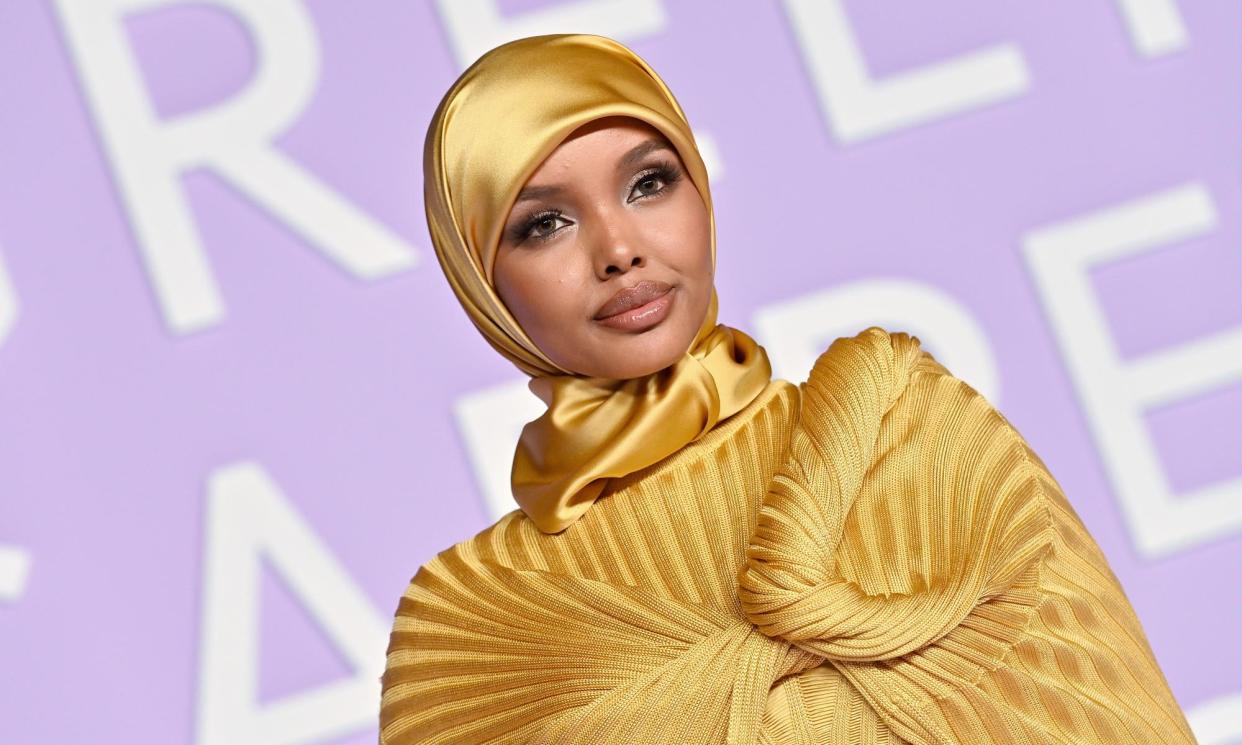When is modest fashion desirable? When it’s called ‘quiet luxury’

Last month, supermodel Halima Aden announced her return to fashion after a three-year break. Aden, the first woman to wear a hijab on the cover of Vogue, quit the industry citing difficulties reconciling her faith and her career. A devout Muslim and proud hijabi, Aden previously shared her frustration with fashion’s attitude to modest dressing. Annnouncing her departure from the catwalk, she said: “Looking back now I did what I said I would never do, which is compromise who I am in order to fit in.”
Now, Aden recognises that changes have been made since she left – and told Grazia she is excited to see what more the industry might do to finally bring modest dressing in the mainstream. “If we continue down this trajectory, we will see lasting change,” she says in her cover interview. “I was blessed enough to have been the first. But I’m not the last.”
Aden’s re-emergence comes at an interesting moment where modest fashion is seeing an uptick in attention. On Pinterest, searches for “modest fashion outfits” are up 80% since last year and “modest outfits” by 40%. “Through rising search data, it’s clear that more considered and covered looks are becoming increasingly popular, especially among gen Z,” says Jenna Waller, head of fashion at Pinterest UK.
From Cos to Arket, modest styles are becoming ubiquitous on the high street, while Max Mara’s collection at Milan fashion week was consciously curated to showcase modest looks. As the brand’s creative director Ian Griffiths put it: “My interpretation of dignity is what I showed today. Clothes that show whoever is wearing them in their best light, to show off their beauty but in a way that never degrades them.”
Quiet luxury, old money and Scandi minimalism are all trends on TikTok with billions of views – and all have a pared-back aesthetic in common with soft tones, long hemlines and a leaning towards modesty.
But this resurgence has caused some frustration among Muslim content creators, who feel overlooked. They point to a double standard around when the fashion industry and media choose to call modesty “desirable”, and when they don’t. In popular culture dressing modestly when linked to Islam has been characterised as restrictive or even oppressive, but the tone around it feels markedly different when it is an aesthetic choice by an influencer.
The double standard is neatly summed up by a wedding that took place earlier in the year. When Sofia Richie married music executive Elliot Grainge in April, TikTok exploded. Many praised Richie, the model daughter of American singer Lionel Richie, for her decision to dress “modestly” – she wore three custom Chanel gowns and the first in particular, high-necked, long-sleeved and intricately beaded was modest in nature. On TikTok, users crowned Richie the “modest queen” and shared their takes on how to achieve modest looks, including layering techniques to ensure full cover.
One user on X expressed their frustration: “Is it normal that I feel frustrated at the narrative that Sofia Richie has ‘begun’ a trend of modesty? Muslim women have been fighting so hard to make people understand that there’s class and elegance in covering up,” she continued, “and that it’s not always a manifestation of oppression.”
Proof of that fight abounds. In September, for instance, a French court upheld a ruling to ban abayas, a loose dress many Muslim women wear, in state schools.
Mariah Idrissi, the first model to wear a hijab for H&M, in a 2015 campaign, sees this double standard around when modesty is deemed not just acceptable but also aspirational. “It’s inevitable that when a celebrity does something that is normal to many, it suddenly becomes a thing.” She recognises that even the H&M campaign that catalysed her career bore signs of that double standard. “There had been so many Muslim bloggers and YouTubers promoting modest fashion before the campaign and no one gave them the time of day,” she says. But Idrissi is thankful that it was her who was chosen to do the campaign: “I am Muslim and that representation is crucial to show it’s not just a trend, it would be weird if they just stuck a hijab on a non-modest model and did the campaign.”
Some brands have made strides to increase inclusivity when it comes to modest options. Recently, for instance, both Louis Vuitton and Net-a-Porter launched Ramadan edits.
But to ensure that modesty is not viewed as a trend, with recognition only through seasonal edits, Minal Malik, a senior lecturer at the London College of Fashion, says the goal should be to have no differentiation between modest fashion and “normal fashion”. “Western brands,” she says, “are important in making modest fashion more accessible and it’s a way of breaking down stereotypes and promotes an understanding between different cultures.”
Brands such as The Reflective, an online marketplace for the latest modest high-fashion items, are challenging perceptions. A key feature is the brand’s attempt to appeal to everyone. “We removed religious language from our branding,” say its founders Liza Sakhaie and Ariella Immerman. “With the imagery we create we always try to represent different groups,” they say. “That way the platform feels like it’s for everyone.”
There also needs to be greater choice and an understanding that, when it comes to modesty, there is not a one-size-fits-all way of getting dressed. “It’s not all long dresses,” says Malik. Back again to Aden and her triumphant return. What better proof is there of modest dressing’s ability to be fashion-forward than her, beaming out from a magazine cover, wearing an outfit every bit as fashion-forward as it is modest.
To read the complete version of this newsletter – complete with this week’s trending topics in The Measure and your wardrobe dilemmas solved – subscribe to receive Fashion Statement in your inbox every Thursday.


